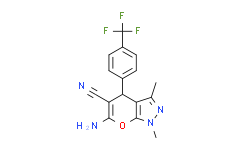| Cas No.: | 1637739-82-2 |
| Chemical Name: | BQU57 |
| Synonyms: | BQU57;6-amino-1,3-dimethyl-4-(4-(trifluoromethyl)phenyl)-1,4-dihydropyrano[2,3-c]pyrazole-5-carbonitrile;BQU-57;6-Amino-1,4-dihydro-1,3-dimethyl-4-[4-(trifluoromethyl)phenyl]-pyrano[2,3-c]pyrazole-5-carbonitrile |
| SMILES: | NC1=C(C#N)C(C(C(C)=NN2C)=C2O1)C3=CC=C(C(F)(F)F)C=C3 |
| Formula: | C16H13F3N4O |
| M.Wt: | 334.295833349228 |
| Purity: | >98% |
| Sotrage: | 2 years -20°C Powder, 2 weeks 4°C in DMSO, 6 months -80°C in DMSO |
| Description: | BQU57 shows selective inhibition for Ral relative to Ras or Rho and inhibit xenograft tumor growth similar to depletion of Ral by siRNA. The IC50 for BQU57 of 2.0 μM in H2122 and 1.3 μM in H358.IC50 value: 2.0 μM (H2122 cell), 1.3 μM (H358 cell)Target: Ralin vitro: BQU57 inhibits Ral binding to its effector RalBP1, Ral-mediated cell spreading in murine fibroblasts and anchorage-independent growth of human cancer cell lines.in vivo: H2122 xenograft tumors are collected 3h after a single intraperitoneal injection BQU57 (10/20/50 mg/kg) and activation of Ral in the extracts is analyzed in RalBP1 pull-down assays. Both RalA and RalB are significantly inhibited by BQU57. By contrast, no inhibition of Ras and RhoA activity is observed. |
| References: | [1]. Yan C, et al. Discovery and characterization of small molecules that target the GTPase Ral. Nature. 2014 Nov 20;515(7527):443-447. |

 DC Chemicals' products qualify for U.S. tariff exemptions. We guarantee no price increases due to customs duties and maintain stable supply, continuing to deliver reliable research solutions to our American clients.
DC Chemicals' products qualify for U.S. tariff exemptions. We guarantee no price increases due to customs duties and maintain stable supply, continuing to deliver reliable research solutions to our American clients.





















